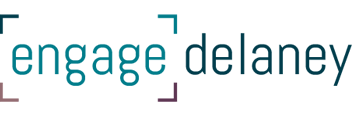Be a Change Maker … help your organization move beyond its comfort zone
by Richard Delaney, President, Delaney, the engagement people
Funny how sometimes your unconscious self smacks you on the side of the head to help join the dots.
I loved Valerie’s blog from a couple of weeks back about how we are all being challenged to move out of our comfort zones. It made me think of a blog Jessica posted in the spring called Be Kind, Be Calm, Be Safe. She was talking about Dr. Bonnie Henry (BC Provincial Health Officer) and her gentle, compassionate, compelling style of leadership. Then, just last week, while I was leading a group of P2 professionals through an IAP2 Techniques course, we were talking about learning objectives and engagement “fears” from the pre-course survey, and it hit me right there … on the side of the head.
After that smack, I looked at past course results and I can tell you that in every single one of the over 50 courses I’ve delivered in the past five years, I’ve heard the same thing – presented as either a learning objective or an engagement fear: how to get internal buy-in / senior management support for engagement results. The word “results” is really important here. Lots of organizations are doing engagement, and a few are taking it seriously. I hear the frustration in every single course, and frankly, many times it is the most common theme.
So, what do these survey results have to do with comfort zones and compassionate / compelling leadership? In a word – everything, if engagement professionals are to be change agents working inside their organizations. They need to own the responsibility to help their organization move to a different place and that place is where the voices of external parties are heard and gain traction with senior decision makers.
In my experience, the public engagement comfort zone for many organizations (public and private) lives at the INFORM level of the Spectrum. Print some flyers. Do an open house. Answer some questions, if anyone shows up. Then, wonder why people are surprised and upset when the decision gets announced.
Why does this happen? I think it happens because many senior decision makers have experienced really negative results brought on by bad engagements in the past. They fear committing to anything more than the bare minimum and so the cycle repeats itself.
As internal P2 professionals, we must demonstrate compassionate and compelling leadership by accepting our leaders are wary of being vulnerable with their publics, their key external parties, for good reason. Our role is to work without judgement from where they are – to ask really good questions that help them think through an approach to meaningful engagement for their pending decision. It goes something like this:
Them – We need to do some engagement focus groups.
You/Me – OK, what we hoping to get out of these focus groups?
Them – We need to hear what people are thinking.
You/Me – Thinking about what?
Them – About project X.
You/Me – OK. What specific parts of the project are you looking to hear about?
Them – Well, it would be good if we knew what they were thinking about Y and Z.
You/Me – That makes sense. We’ll need to collect that input in good time so we can consider it properly. When in the decision-making process do you think you’ll need that input, to keep the project on schedule?
Them – I’d say by this date.
You/Me – OK. Let’s use the industry standard approach to engagement planning. With that best practice, we should have one or two engagement objectives before we organize the event, so we control the process and know exactly what we want to get out of it. How about I draft up one or two objectives and run them past you?
This it when you develop your engagement objectives using the Delaney format of:
Objective = spectrum level + interested and affected parties + purpose + timeline.
individual outcomes + outputs
Remember the “purpose” is the decision point (aspect or dimension) at which you are intending to bring external parties into the decision-making process.
After you get buy in on the objectives, work to better situate the engagement objectives within the decision process by creating a high-level decision process map. At this point, you are in good shape to share some information about how to best match techniques to the spectrum level and desired outcomes and outputs. And don’t forget to prepare participants with some INFORM-level objectives.
Our approach is to develop an engagement roadmap that shows each decision step in a row within a table. The next row shows the timeline for each step, the row under that shows engagement objectives for steps where/when engagement will take place and the next row shows the techniques to be used.
Our experience is that decision makers totally appreciate this big picture view, where they can see how the decision will unfold and how engagement will add value. Check out page ten of this plan. It’s for an educational institution, so they make all their engagement materials available publicly. We are proud to call the Calgary Board of Education our client.




